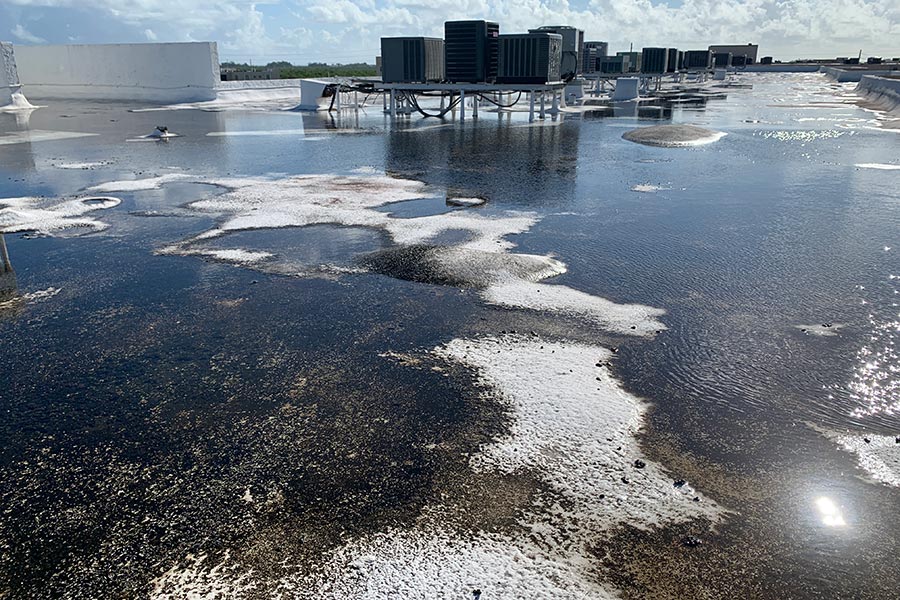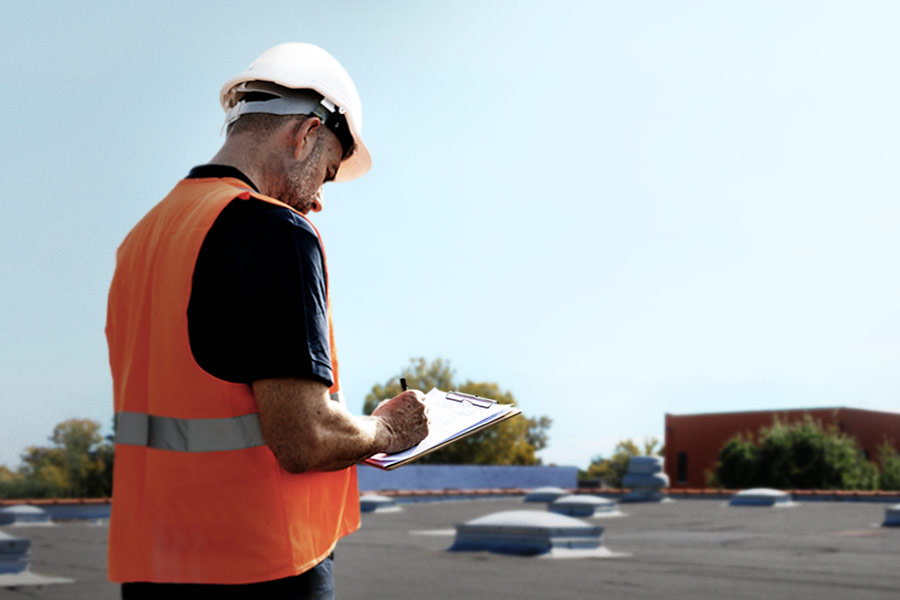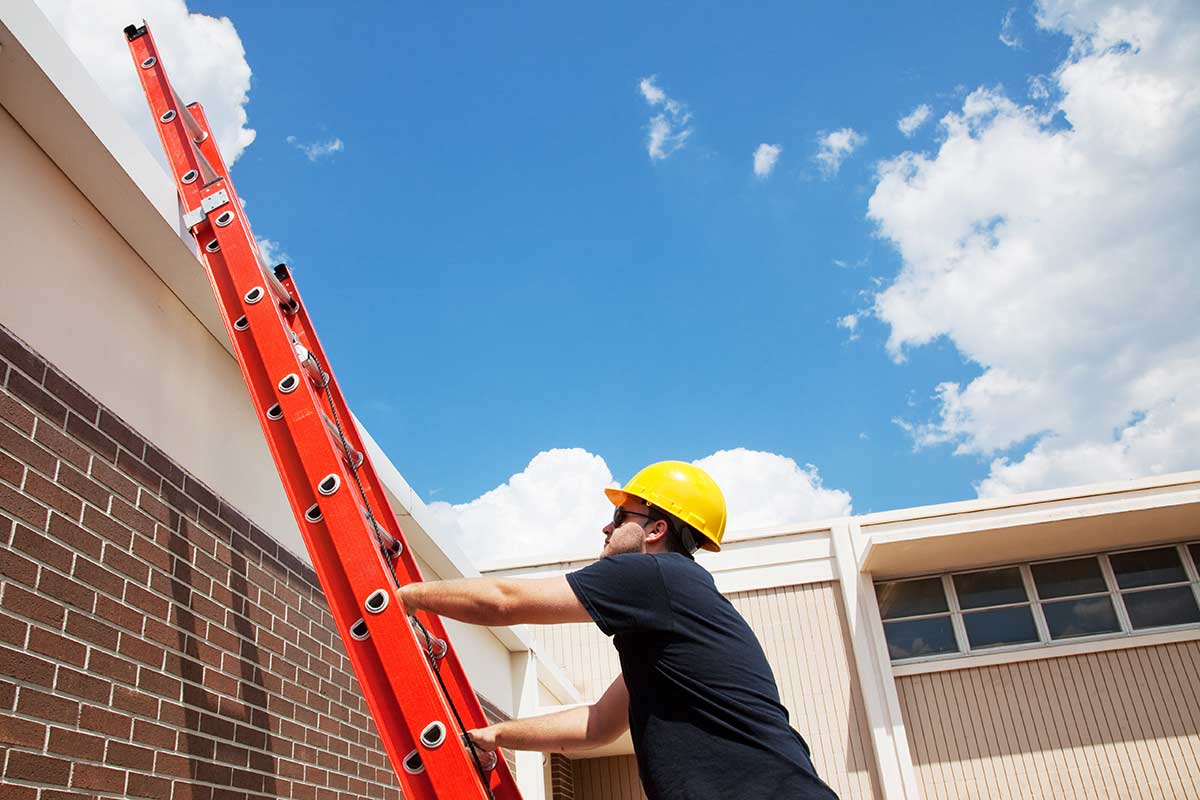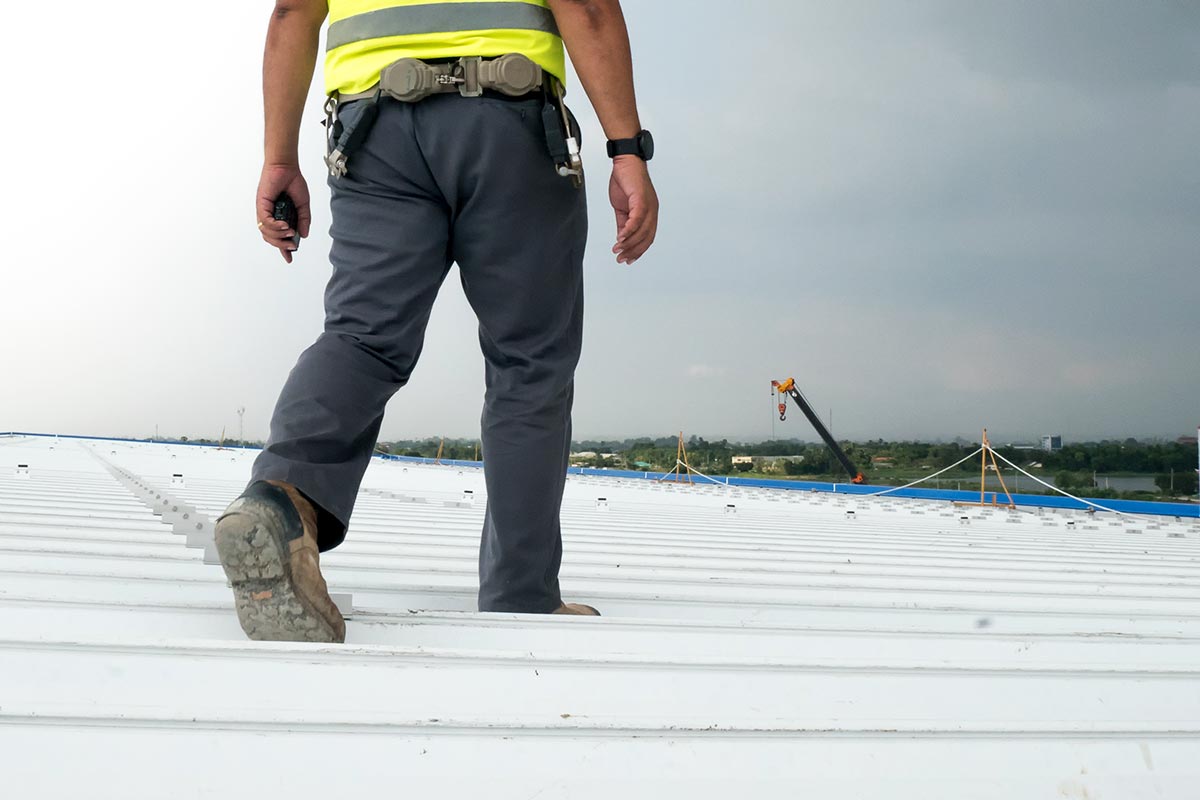
A commercial roof repair may be a practical option without replacing it entirely, which is critical for the roof’s longevity. Methods for commercial roof repairs are preventative treatments that aid in averting more severe and costly problems in the future.
Also, hiring a reputable commercial roofing contractor will guarantee that your roof lasts as long as possible. The service life of your roof may be extended using the advice provided below, ultimately saving building owners a sizable amount of money.
Before getting into the first signs of commercial roof repair, let’s discuss common causes.
Attention! If you have a commercial roof needing repair, click here to schedule a free evaluation with an American WeatherStar Approved Contractor.
Common Causes of Commercial Roof Leaks
Punctures in the Roof’s Surface
The most frequent commercial roof repairs are those caused by surface rips or punctures. Any sharp object, such as a tree branch, hail, trash left on the roof, or even foot traffic walking across the flat roof’s surface, might create this.
The roof becomes leaky with just one little hole. Depending on the roofing materials, you should take adequate precautions before stepping on the roof or carrying heavy objects.
Improper Sealing Around Roof Penetrations
In most cases, the sealant is a silicon-based caulking that prevents water from entering the roof structure. It is utilized when flashings are nailed down, when there is a junction between them, or when they are not tight enough. The penetration or flashing is especially vulnerable to water infiltration and leakage if the sealant is fractured or degraded. It is crucial to confirm that the sealant your roofer used continues to be durable year after year. Thus, it is imperative to have a qualified roof inspector do a semi-annual roof survey.
Failed Roof Flashing
Flashings are often constructed of copper or galvanized metal intended to divert water away from the roofing materials, particularly near valleys and penetrations. This is accomplished during installation by passing the bottom edge of the flashing over the roofing material immediately below it and then passing the top edge of the flashing below the underlayment directly above it. But, if the flashing subsequently starts to degrade, the seams, nails, and joints below it become exposed to the elements of nature, leading to a significant leak.
Old Materials and an Aging Roof
As it ages, your roof will experience more significant wear and tear, and the roofing materials will lose some durability. Your roof will eventually wear out, which is why commercial roof repair is essential. With sound construction and upkeep, most commercial flat roofs only survive 10–20 years on average.
To increase the lifespan of your roof, it is essential to have routine roof inspections and minor repairs as necessary. Before a complete replacement becomes essential, repairs might buy a lot of time.
Poor Drainage of Rainwater, Ice, and Snow
Rain and snow will collect on your commercial roof if your roof isn’t handling them. This standing water (and melting ice) can harm any industrial roofing material and threaten flashings around penetrations and connections between panels.
A commercial roof must have a modest slope, gutters drain, and adequate insulation for water and snowmelt to drain off of it properly. Without proper insulation, a roof won’t warm enough to melt the snow and ice, which might collect or re-freeze at the edges and cause leaks.
Poor Installation by an Inexperienced Contractor
A qualified roofing contractor with extensive expertise is required to construct commercial roofing systems. Depending on the size and complexity of your rooftop, correctly installing a roof might take days, weeks, or even months.
Also, always search for contractors who provide a strong quality warranty to cover any problems arising from the installation and commercial roof repairs. This demonstrates their commitment to their work and ensures your protection in the event of an incident involving their account.
Neglecting Maintenance
Commercial roofs are subject to the environment daily, just like any other roof. The danger of damage rises due to their natural exposure to deterioration and decay. The safety and effectiveness of a facility depend on the maintenance of commercial roofs.
When someone is on public property, you want to ensure they are as safe as possible. This includes anyone who passes by or works in the facility. The building’s ceiling, walls, and foundation of the building will all benefit from regular roof maintenance and the rest of the structure.
The problems that might harm the roof include pooling, bubbling, and loose flashing, to name a few. Most of the time, it is advisable to address commercial roof repairs immediately.
What are the first signs your commercial roof needs repair?
Areas of Pooling Water
When water accumulates and stagnates on a roof’s surface for more than 48 hours, it is said to be “ponding.” Huge puddles may develop on the roof surface if the drainage system is inadequate for the building, among other reasons related to the infrastructure of the building or the roof design.
Cracked or Damaged Membrane
Roof alligatoring may eventually necessitate replacement. If not repaired immediately, cracks can continue spreading through the roofing material, resulting in water damage. Rather than doing several costly and time-consuming repairs at this stage, it would be wiser to replace the roof.
Blistered or Bubbling on the Roof’s Surface
Roof blisters can happen on any traditional, low-slope, and flat roofing system, although they tend to occur more frequently on membrane systems and built-up roofs (BUR).
Moisture and air can accumulate in the spaces between roofing plies or between the ground and the membrane. Roof blisters result from the expansion of water vapor brought on by rising temperatures. The underlying surface could be exposed to the elements if the blister is pierced. This might lead to water entering the roofing system and even the interior of your property, which would result in mold development and water damage.
High Energy Costs
Leaks cause your HVAC system to work harder by allowing warm or cold air to escape your building. Moreover, they cause greater humidity levels, which promote mold formation.
Poor Drainage
On a commercial roof, poor or nonexistent drainage is a sign of future trouble. Ponding water must be removed since it can accumulate debris, impair roof seams and other membrane connection points, encourage the growth of mildew and plants, and harm the facility’s structural integrity.
Mildew and Mold Growth
Mold and algae enjoy damp environments that may develop unhindered throughout their lifecycles. Many industrial flat roof surfaces may not have a chance to fully dry out and eradicate the algae and mold spores during periods of heavy rain and higher temperatures. Without this organic drying process, mildew and algae can spread uncontrollably across the flat roof’s surface.
Although mold and algae won’t harm your roofing system other than by changing the visual appearance of your roof, they are a warning indication of something more serious. The presence of algae and mold on a roof indicates that water has been sitting there for a while, generally due to a drainage problem.
What can you do to protect your commercial roof?
Maintain Records
It is vital to keep all information and documentation about your roof. Building owners and facility managers should know the roof’s size, age, and maintenance history. These records must be stored in a location that is both secure and easily accessible.
Guarantees and warranties, records of maintenance and commercial roof repairs, and modifications or upgrades to rooftop mechanical equipment should all be part of your roofing file. It must have a dimensioned roof design that details the drainage system, the kind and quantity of thermal insulation, the size and placement of mechanical equipment, and the nature of the edge conditions around the perimeter. Recording staff members’ work on other roof fixtures, such as HVAC systems, skylights, etc., is also a good idea.
Conduct Routine Inspections
Frequent roof inspections allow you to make the required adjustments and prevent leaks and expensive repairs. You may save time, money, hassles, commercial roof repair expenses, and expenditures to replace the inside of the building by taking care of these issues before they explode.
Repair Correctly
Choose your roof inspector wisely. Your roofing inspector may evaluate and define any potential risks or problems to your roof. As crucially important as the roof itself is, an inspector you can rely on and a competent, certified specialist will give your roof and business their full attention and examination.
Keep the Roof Clean and Free of Debris
Maintaining a clean, debris-free roof is critical, just like any other structure. Leaves and other debris might not first seem to be able to harm a durable commercial roofing system. Still, if left unattended, these minor messes can eventually become serious issues, leading to leaks and other damage.
To prevent water damage to your roof or structure, it is imperative that proper cleaning be done on the gutters, drains, leader boxes, and scuppers regularly. A properly working roof system will be ensured by routinely hiring a professional to clear away debris and assess the longevity of your drain systems.
Maintain Roof Coating if Present
Roof coatings are liquid solutions applied directly to your existing roof by rolling or spraying. The goal is to prolong the life of your current roof without having to replace it. It gives an additional defense against sunlight, moisture, and other hazards. Roof coatings are a great way to halt cracks, corrosion, and other issues while delaying a roof replacement.
No coating, not even those in a maintenance program, can fix a deteriorated roof. However, building owners can significantly reduce the lifecycle cost of the new or existing roof membrane by implementing a proactive, routine maintenance program that correctly uses the defined coatings instead of the regrettable but common approach of neglect, repair, and re-roofing.
Recommended reading: Roof Restoration: The Comprehensive Guide
Minimize Rooftop Traffic
You have no control over routine roof maintenance. It’s crucial for preserving the structural integrity of your roof. While it is hoped that there won’t be any damage during the initial months and years of routine upkeep, harm can be progressively inflicted over five to ten years of unchecked use.
Essential inspections should follow the same general routes for regular foot traffic. The tension on roof membranes can be reduced by installing rooftop walk paths along these popular routes, avoiding unintentional harm.
Conclusion
So how can you determine when a business roof has to be repaired? The warning signals are apparent; if your business roofing system is maintained, it should remain for a while.
While putting off commercial roof repairs for too long might result in irreversible harm to your roof, your building’s structure, and the inside, repairs can be a method to preserve your roof throughout its lifespan. The risk can be reduced with routine inspections. And if you frequently have to repair your commercial roof, it could be time for a complete roof replacement.
If you want to schedule a free roof inspection, contact an American WeatherStar Approved Contractor today.
Related Posts
In Need of a Commercial Roof Inspection?
Perhaps you’ve noticed leaks in your building or unsightly brown stains on the ceilings and interior walls. Whatever the case may be, these…
How to Establish a Roof Maintenance Program
The most important reason for establishing a roof maintenance program is to protect the capital investment of a new roof. Proper maintenance…
5 Commercial Roof Maintenance Best Practices
Having a solid plan for commercial roof maintenance and repairs is critical to keeping your roof strong and preventing premature roof failure.…


























